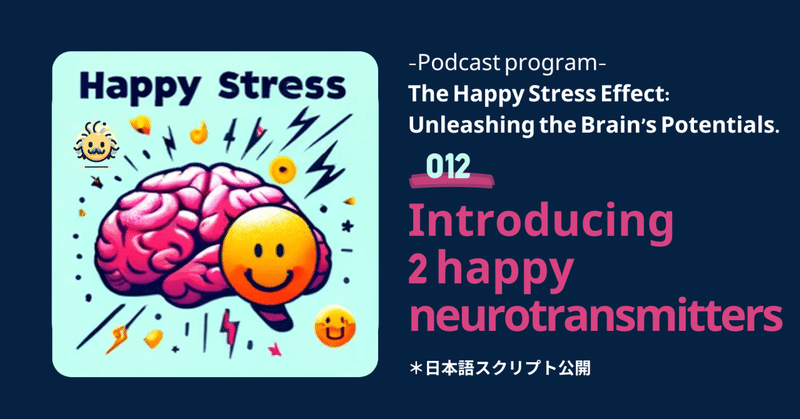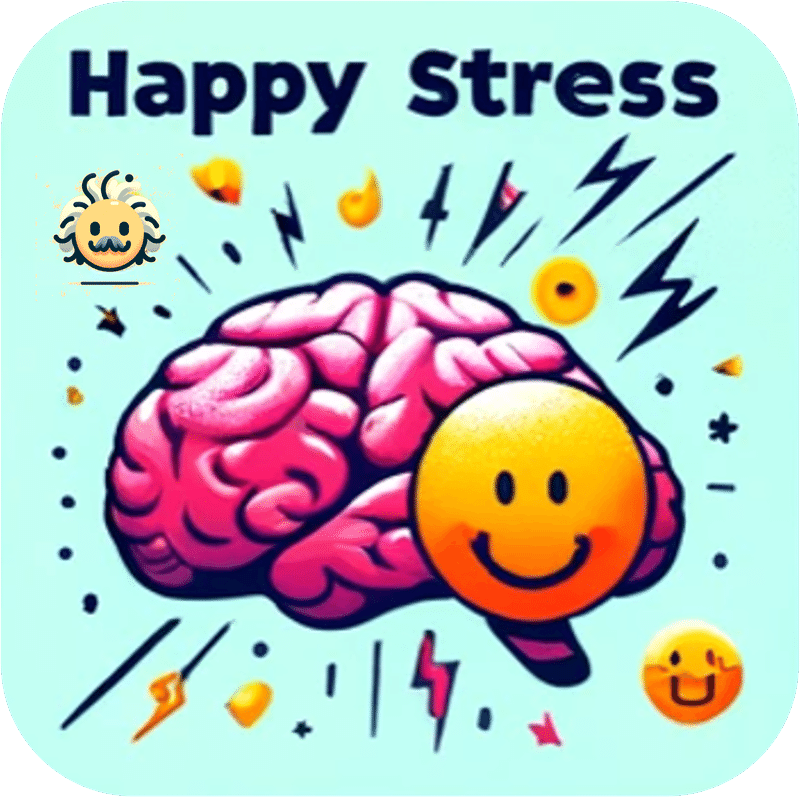
【The Happy Stress Effect 012】 Introducing 2 happy neurotransmitters
毎週月曜日の午後に更新!
海外の方々に向けて、英語でHAPPY STRESSを紐解くPodcast番組 『The Happy Stress Effect: Unleashing the Brain’s Potentials』
今週も、第12回エピソードをSpotifyにて配信開始いたしました!
今週のテーマは「ハッピーな神経伝達物質をご紹介」!
本記事では、日本語訳と英語のスクリプトをお届けいたしますので、あわせてお楽しみいただけましたら幸いです✨
012- Introducing 2 happy neurotransmitters (2024/04/1)
Script Translation/日本語
*以下はChatGPTを使用して日本語に翻訳しています。かなり精度は高まってきていますが、まだまだ完全ではございません。そんなGPTさんの成長も楽しみながらお読みいただけますと幸いです。
皆さん、こんにちは。『The Happy Stress Effect: Unleashing the Brain’s Potentials』の世界にようこそ。私は進行のアルバートです。今日は、私たちの生活であまりにも馴染み深いトピック「ストレス」について掘り下げていきます。でも、ちょっといいですか?これは複雑な科学用語を深く掘り下げるということではありません。ストレスを共感できるものにし、理解しやすく、何よりも日常生活に適用できるようにするためのものです。
実際、ストレスは単なる敵ではなく、私たちを守り、強化し、成長させるために不可欠な要素でもあるのです。この番組では、私たちの脳と体が基本的なレベルでストレスとどのように相互作用しているかを探っていきます。なぜストレスが私たちの生物学と人間性の自然な一部なのか、そしてこれを知ることが私たちがそれをどのように捉えるかを変えることができるのかを明らかにしていきます。でもそこで終わりません。
科学と技術の進歩により、私たちは今、ストレス反応を操る細胞や分子にのぞき込むことができます。私たちは、これらの魅力的な洞察のいくつかを「Happy Stress」(青砥瑞人 著)という書籍を使って、理解しやすい形で明らかにしていきます。
前回のエピソードでは、「見返りバイアス」という概念について掘り下げました。これは、私たちが行動や貢献に対して無意識のうちに報酬を期待する心理的傾向です。この先天的な期待がいかにして私たちの交流や幸福感に微妙な影響を与え、期待される報酬が現れないときにはしばしばフラストレーションにつながるかということについて話し合いました。
今日は、脳と体内の恒常性(ホメオスタシス)のメカニズムを掘り下げることで、「ダークストレス」へのアプローチを広げることを目指します。私たちは、ストレス反応を示したときにストレス状態を軽減するために設計された先天的なシステムを持っており、この学びに焦点を当てたいと考えています。皆さん自身の環境内で、どのような要素や条件がさまざまな形の恒常性を促進するかを考えてみてください。
良い笑いやリズミカルなビートがどのようにして気分を変えることができるのか、またはなぜ特定の活動が説明のつかない喜びをもたらすのか、不思議に思ったことはありませんか?この質問に答えるために、2つの重要な神経伝達物質を紹介したいと思います。
まず、脳内アヘンとも呼ばれるβエンドルフィンという神経伝達物質について話しましょう。この物質は、快楽と関連しており、脳内で自然に生成され、痛みを軽減し、穏やかな気持ちを高めることができます。
たとえば、お腹の底から笑うことは、βエンドルフィンの生成を促し、笑いが私たちの内部状態の調整機関として機能することを示唆しています。
よく知られている例として、アメリカの編集者であるノーマン・カズンズが挙げられます。彼は50代になって膠原病と診断されました。彼はその痛みを、トラックに轢かれた感覚に例えて説明しました。この中で、カズンズは毎日コメディ番組を観ることを心掛けました。
その理由は、明確な治療法が見えない絶望の中で、否定的な思考にとらわれることが彼の身体状態をさらに悪化させると信じていたからです。コメディを観ることで、良い笑いが一時的に彼の痛みを和らげることに気づきました。当時はそのような考えが却下されましたが、今では笑いがβエンドルフィンの放出を引き起こし、痛みを和らげ、免疫系にポジティブな影響を与えたと考えられています。
カズンズは、治療不可能とされた病気を克服しました。笑いが唯一の治療法ではありませんでしたが、その顕著な治療効果は否定できません。
心理的ストレスの陰湿な性質は、それが微妙にストレス反応を増幅させ、私たちの気分を落ち込ませるだけでなく、免疫機能を損なうことにあります。否定性にとらわれるほど、私たちの注意はそれに固定され、否定的なループに陥ってしまいます。したがって、私たちの人生に本当に笑わせてくれるものがあることは、ダークストレスから解放され、回復に備えるための重要な要素です。
多くの文明と文化を通じてコメディとユーモアが存在し、人々に愛されていることは、人類が歴史的に笑いを通じてさまざまなストレス反応をうまく乗り切ってきたことを示唆しています。
もちろん、何が一人ひとりを笑わせるかは、私たちの脳に蓄積された独自の記憶によって異なります。自分の笑いのツボを再認識し、それを人生に組み込むことで、私たちの存在を豊かにすることができます。
βエンドルフィンに加えて、セロトニンもまた重要な神経伝達物質です。
コメディやユーモアが多くの文明と文化に普及しているように、音楽とダンスもそうです。これは単なる偶然でしょうか?音楽やダンスに身を委ね、楽しむことは本能的なように感じられますが、なぜ人間は最初に音楽を創造したのでしょうか?
その鍵は、そわそわすることにあります。そわそわすることとダンスを同等にするのは無理がありますが、両方の活動はストレス反応や不満から生じ、足をたたいたり、指をいじったりさせるのです。なぜでしょうか?
繰り返しのリズミカルな動きが脳内でセロトニンの生成を促進できることが知られています。そのため、そわそわすることはストレスへの適応的な反応であり、リズム運動を通じて過剰なストレスを緩和しようとするものです。
多くの人が、音楽に合わせて踊ったり、リズムに身を委ねたりするときに心地よさを感じることでしょう。これは、セロトニンの効果に部分的に起因するものです。 この視点は、繰り返しの単調なリズム運動の普遍性を示しています。たとえば、なぜ子どもをなでて眠らせるのでしょうか?リズミカルななで方は、介護者と子どもの両方を落ち着かせるようです。
音楽やダンス、噛むこと、歩くこと、木魚の規則的な拍子など、それらはすべて、より深い意味を持っていそうです。なぜ野球選手がベンチでガムを噛むのか、それ自体が落ち着かせるからです。鍵は、自分に合った繰り返しのリズムを見つけ、それを最大限に効果的な落ち着きのルーティンの一部と認識することです。
このような動作を行う際には、無意識にストレスを引き起こすことがあります。「なぜこれをしなければならないのか?」というような考えから生じるストレスです。これらの動作が自分自身の落ち着きの儀式として機能することを意識的に認識することで、思考によるストレスを防ぎ、セロトニンの放出によるリラックスを促進できます。
「なぜこれをしているのか?」と考えることは、セロトニンを誘導するのに必要な脳の機能を妨げるため、逆効果です。したがって、自分の落ち着く場所、行動、ルーティンを見つけ出し、意識的に受け入れることで、その効果を高めることができます。
有名なエグゼクティブたちは、リラックスするために皿洗いをするような日常的なルーティンを持っており、女性起業家のイベントでは、とある女性が「仕事にイライラしたとき、帰り道でキャベツを3玉買って細かく刻みます。それが落ち着かせてくれるんです」と共有してくれました。皆さんにも繰り返し行うことで落ち着きを取り戻す独自の形式があるでしょう。これらの行動を再発見し、意識的に生活に取り入れることは有益であるかもしれません。
やや負荷のかかる運動を取り入れることで、βエンドルフィンとセロトニンの性質を効果的に利用できます。
ダークストレスと戦う運動の利点は、十分に裏付けられています。ややハードな身体活動に従事することで、身体や脳内でさまざまな反応が引き起こされ、ストレス反応が軽減されます。
ダークストレスを緩和する目的で運動する際のポイントをいくつか紹介しましょう。
中程度の強度の活動が推奨されます。非常に激しいトレーニングも効果的ですが、定期的な運動に慣れていない人にとっては持続可能ではないかもしれません。逆に、あまり負荷のかからない運動は、重要な効果を生み出さない可能性があります。
運動の強度の認識は個人によって異なるため、活動がややチャレンジングに感じられるが圧倒されることがないバランスを見つけることがストレス解消の鍵です。
このバランスによって、運動することに十分な集中力を要し、ストレスフルな思考に戻るのを防ぎます。一方、あまり集中力を要しない活動では脳が十分に関与せず、ネガティブな経験について考え込んでしまうかもしれません。
より激しい運動やヨガ、ダンスのような複雑な動きは、脳が十分に関与するため、心理的なストレス要因から気を逸らすのに効果的です。
運動ルーティンに慣れてくると、徐々に脳の関与が少なくなる可能性があるため、集中力を維持し、強度を調整したり、新しい活動を導入することで、運動がダークストレスの管理に役立つように保つことが重要です。
やや負荷のかかる運動を行うことは、筋肉に物理的なストレスを与え、脳や身体がβエンドルフィンやセロトニンなどの化学物質を生成するよう促します。
理由は何であれ、身体活動によって合成された場合でも、脳や体が生成したβエンドルフィンやセロトニンはその分子構造を保ち、心理的ストレスに対して効果的です。
「ランナーズハイ」というのは、激しい運動の身体的負担にもかかわらず幸福感を感じる現象で、これは体が大きなストレスに反応して、快感を引き起こす化学物質を放出するからです。
適切な運動を日常生活に取り入れることで、ダークストレスを軽減するだけでなく、学びや健康上のメリットも得られます。やや負荷のかかる身体活動は、ライフスタイルに取り入れる価値があります。
今日のエピソードの結びです。私たちの身体と脳はバランスを保ち、幸福感を促進するための素晴らしいシステムを備えていることが明らかになりました。βエンドルフィンやセロトニンの役割を理解することで、笑いや音楽、リズミカルな動き、さらには適度な運動が、ストレスを軽減するだけでなく、全体的な幸福と健康を向上させる方法を学びました。肝心なのは、これらの有益な反応を自然に促す活動を取り入れる力です。日常生活でユーモアを見つけたり、音楽を楽しんだり、身体活動を習慣に取り入れることで、私たちの体が自己調整し、回復する能力をサポートしましょう。自然のメカニズムを受け入れ、精神的・身体的健康を育むために意識的な選択を行いましょう。幸福な一歩を踏み出す旅が始まります。
それでは、本日の『The Happy Stress Effect: Unleashing the Brain’s Potentials』をお聴きいただきありがとうございました。もし本日のエピソードをお楽しみいただけたなら、ぜひチャンネル登録をお忘れなく、ハッピーの科学へのさらなる洞察をお楽しみください。次回まで、私、アルバートが「HAPPY STRESS」と喜びに満ちた一日をお祈りしています。

Original Script/英語
Welcome, everyone, to "The Happy Stress Effect: Unleashing the Brain’s Potentials". I'm your host Albert, and today, we're delving into a topic that's all too familiar in our lives - stress. But hold on, this isn't going to be a deep dive into complex scientific jargon. We're here to make it relatable, understandable, and most importantly, applicable to our daily lives.
You see, stress isn't just an adversary; it's also a vital component that protects, strengthens, and even fosters growth within us. In this program, we're exploring how our brains and bodies interact with stress on a fundamental level. We'll uncover why stress is a natural part of our biology and humanity, and how knowing this can reshape the way we perceive it. But it doesn't stop there.
With advancements in science and technology, we're now able to peek into the very cells and molecules that orchestrate our stress responses. We'll be demystifying some of these fascinating insights using this book called "Happy Stress" by Mizuto Aoto in a way that's easy to grasp.
In our last episode, we delved into the concept of "reward bias," a psychological tendency where we subconsciously expect a return for our actions or contributions. We discussed how this innate expectation can subtly influence our interactions and well-being, often leading to frustration when the anticipated return doesn't materialize.
Today, we aim to broaden our approach to dark stress by delving into the mechanisms of homeostasis within our brains and bodies. We possess innate systems designed to alleviate stress states when we manifest stress responses, and it's this learning we wish to focus on. I invite each of you to consider, within your own environments, what elements or conditions might facilitate various forms of homeostasis.
Ever wondered how a good laugh or a rhythmic beat can transform your mood? Or why certain activities bring us inexplicable joy? To answer this question, I want to introduce two important neurotransmitters.
First, let's discuss a neurotransmitter called beta-endorphin, often referred to as the brain's opiate. This substance, associated with pleasure, is naturally produced in the brain and can lessen pain and enhance feelings of peace.
For instance, genuine belly laughter can prompt the production of beta-endorphin, suggesting that laughter serves as a regulator of our internal state.
A well-known example is Norman Cousins, an American editor who, upon reaching his fifties, was diagnosed with a connective tissue disease. Describing his ailment, he likened the constant pain to the sensation of a truck running over him. Amidst this, Cousins made it a point to watch comedy shows daily.
The reason was his belief that, especially in times of despair with no clear cure in sight, dwelling on negative thoughts only exacerbated his physical condition. Through watching comedy, he noticed that a good laugh could momentarily alleviate his pain. While such an idea was dismissed at the time, it's now believed that laughter likely triggered the release of beta-endorphin, easing pain and positively affecting the immune system.
Cousins managed to overcome what was deemed an incurable disease. While laughter wasn't the sole cure, its significant therapeutic effect is undeniable.
The insidious nature of psychological stress lies in its ability to subtly amplify stress responses, not only dampening our mood but also impairing our immune function. The more we dwell on negativity, the more our attention fixates on it, trapping us in a negative loop. Thus, having something in our lives that can genuinely make us laugh can be a crucial element in breaking free from dark stress and preparing for recovery.
The presence of comedy and humor across many civilizations and cultures, cherished by people, suggests that humanity has historically navigated various stress responses through laughter.
Of course, what makes each person laugh will differ, influenced by the unique memories accumulated in our brains from our individual upbringings. Reacquainting ourselves with what tickles our funny bone and integrating it into our lives can enrich our existence.
In addition to beta-endorphin, serotonin is another vital neurotransmitter.
Just as comedy and humor are prevalent across civilizations and cultures, so are music and dance. Is this mere coincidence? Moving and enjoying ourselves to music seems instinctual, but why did humans create music in the first place?
The clue might lie in fidgeting. While it's a stretch to equate fidgeting with dancing, both activities arise from stress responses or frustration, leading us to tap our feet or fiddle with our fingers. Why?
It's known that repetitive rhythmic movements can facilitate the production of serotonin in the brain. Fidgeting, then, is an adaptive response to stress, an attempt to moderate excessive stress through rhythmic movement.
While fidgeting might carry negative connotations for many, moving to music or engaging in rhythm can likely stimulate serotonin production. Many might recall a sense of comfort when dancing or moving rhythmically to music, partly attributable to serotonin's effects.
This perspective reveals the ubiquitous nature of repetitive rhythmic movements. For instance, why do we pat children to sleep? The rhythmic patting seems to calm both the caregiver and the child.
Music and dance, chewing, walking, and even the rhythmic beats of a wooden fish during meditation all seem to carry a deeper significance. It might explain why baseball players chew gum in the dugout – the act itself can be calming. The key is finding the repetitive rhythm that suits you and recognizing it as a piece of your calming routine for maximum effect.
Engaging in such activities without mindfulness can inadvertently lead to stress, driven by thoughts like "Why do I have to do this?" Conscious acknowledgment that these activities serve as personal calming rituals can prevent thought-driven stress and promote relaxation through serotonin release.
Pondering "Why am I doing this?" utilizes brain functions that detract from those needed to induce serotonin, thereby reducing the calming effect. Therefore, identifying and consciously embracing your calming spots, actions, and routines can enhance their efficacy.
Famous executives have routines like washing dishes to unwind, and at an event with female entrepreneurs, one woman shared, "When I'm frustrated with work, I buy three cabbages on my way home and shred them. It calms me down." Everyone has their unique form of repetitive, calming activity, from plucking body hair with tweezers to popping bubble wrap or synchronizing finger movements. What's yours? Rediscovering and consciously incorporating these actions into your life could be beneficial.
Incorporating slightly strenuous exercise can utilize both beta-endorphin and serotonin properties effectively.
The benefits of exercise in combating dark stress are well-documented. Engaging in somewhat challenging physical activities can trigger various reactions within the body and brain, reducing stress responses.
Here are some pointers for exercising with the aim of alleviating dark stress: moderately intense activities are recommended. While extremely intense workouts are also beneficial, they might not be sustainable for those unaccustomed to regular exercise. Conversely, too gentle exercises might not yield significant effects.
The perception of exercise intensity varies among individuals, so finding a balance where the activity feels somewhat challenging but not overwhelming is key for stress relief.
This balance ensures that the exercise demands enough focus, preventing the mind from wandering back to stressful thoughts. In contrast, less demanding activities might not fully engage the brain, allowing it to ruminate on negative experiences.
More vigorous activities or complex movements like yoga or dance require significant attention, making them effective in diverting focus from psychological stressors.
Familiarity with an exercise routine might eventually lead to less engagement, so maintaining focus, adjusting intensity, or introducing new activities can keep the exercise beneficial in managing dark stress.
Engaging in slightly strenuous exercise can be seen as applying physical stress to muscles, prompting the brain and body to produce chemicals like beta-endorphin and serotonin to alleviate this stress.
Regardless of the reason, the beta-endorphin and serotonin produced by the brain and body maintain their molecular structures, making them effective against psychological stress even when synthesized due to physical activity.
The concept of a "runner's high" – feeling euphoric despite the physical toll of intense exercise – is attributed to the body's response to significant stress through the release of pleasure-inducing chemicals.
Feeling refreshed after a good workout likely involves sweating and a sense of fatigue, marking an ideal moment for self-reset. Integrating suitable exercise into your routine not only mitigates dark stress but also offers learning and health benefits, making slightly strenuous physical activity a worthwhile addition to your lifestyle.
As we wrap up today's episode, it's clear that our bodies and brains are equipped with remarkable systems for maintaining balance and promoting well-being. Through understanding the roles of beta-endorphin and serotonin, we've learned how laughter, music, rhythmic movements, and even moderate exercise can not only alleviate stress but also enhance our overall happiness and health. The key takeaway is the power of engaging with activities that naturally stimulate these beneficial responses. Whether it's finding humor in the everyday, enjoying music, or incorporating physical activity into our routine, these actions support our body's innate ability to regulate and recover. Let's embrace these natural mechanisms, making conscious choices to nurture our mental and physical health. Remember, the journey to well-being starts with small, joyful steps.
That’ll be it! Thank you for joining us on The Happy Stress Effect: Unleashing the Brain’s Potentials. If you enjoyed today's episode, don't forget to subscribe for more insights into the science of happiness. Until next time, I'm Albert, wishing you a day filled with "HAPPY STRESS" and joyful moments.
